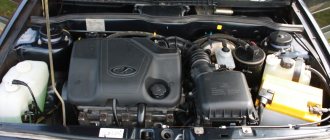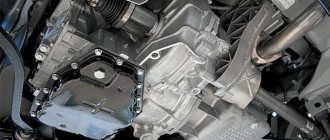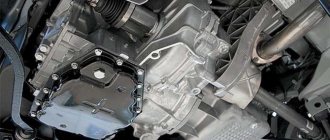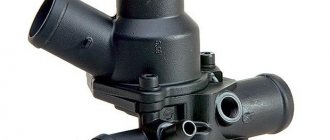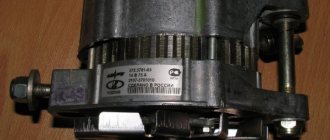For Lada Largus, it is recommended to change the engine oil every 15,000 km. or after 1 year (whichever comes first). Under severe operating conditions (large city, very dusty area), replace the oil and filter every 7-8 thousand km.
| Engine model | Engine oil volume | Factory filled oil | Recommended oils |
| K7M (8 valve) | 3.3 liters | ELF SOLARIS RNX 5W-30 | Motor oils with quality class API SL / API SM / API SN / ACEA A1/ ACEA A2/ ACEA A3/ ACEA A5 and SAE viscosity level: 15W40; 15W50 10W40; 5W30; 5W40; 5W50; 0W30; 0W40 (depending on climatic conditions). |
| K4M (16 valve) | 4.8 liters |
When do you need to change the oil in a Lada Largus engine?
According to the replacement regulations from the manufacturer, it is necessary to change the oil in the Lada Largus engine every 15 thousand kilometers . However, taking into account the specifics of driving and operating conditions, this figure can be reduced to 10 thousand km.
To determine the need to change the oil, pay attention to signs of its depletion. The main indicator is the appearance: color change, the appearance of a burnt odor, impurities and sediment, and a decrease in lubricant thickness.
To detect these signs, regular preventative oil checks are necessary. During this procedure, the lubricant level is also measured using a dipstick. A situation in which the oil remains within the permissible range when heated and cooled is considered normal.
Despite the various processes that will begin with an excess or lack of lubrication in the system, the result will be the same - increased wear of engine components. Its consequence will be expensive repairs and replacement of entire units.
In this context, another set of signs are identified that indicate problems with the lubrication system. They are associated with engine malfunctions, jerking, and extraneous sounds.
Experts do not recommend waiting for such consequences to appear. Their presence indicates not only the need to change the engine oil, but also the demand for a full diagnosis of its components by specialists.
Engine oil for Lada Largus
Lada Largus is a small-class station wagon jointly developed by Renault and AvtoVAZ OJSC, built on the B0 platform of the Renault-Nissan alliance. The car has been produced by AvtoVAZ since 2011 and is a Dacia Logan MCV model adapted to Russian conditions.
Largus has versions for 5 or 7 seats, as well as a modification in the form of a 2-seater van. The model is equipped with a 1.6 liter, 8-valve petrol engine producing 87 hp. (developed by VAZ) or 16-valve 102 hp. (developed by Renault), previously it was also equipped with an 84-horsepower engine from Renault Logan. All cars are equipped with a 5-speed manual transmission.
According to the car manufacturer's instructions specified in the operating instructions, oil for Lada Largus must have API SL, SM, SN or ACEA A1, A2, A3, A5 property levels. What kind of oil to pour into the Lada Largus engine depends on the conditions of use of the car.
TOTAL QUARTZ 9000 5W40
TOTAL QUARTZ 9000 5W40 oil produced using synthetic technology is considered universal and can be used as motor oil for Lada Largus with 8- and 16-valve engines when ACEA A3/B4 and API SN. property levels are required. It has excellent anti-wear characteristics, therefore protects motor from premature wear and deposit formation even in difficult driving modes. Its high fluidity facilitates cold starts and allows this oil to be used in Lada Largus all year round at temperatures down to -25 ̊C. TOTAL QUARTZ 9000 5W40 has good oxidation resistance and retains its properties throughout the entire period between oil changes in Lada Largus, even after significant mileage.
TOTAL QUARTZ 9000 5W40
TOTAL QUARTZ 7000 10W40
Synthetic-based motor oil TOTAL QUARTZ 7000 10W40 has ACEA A3/B4 and API SN property levels, which allows this oil to be used in Lada Largus with engines of all modifications. It guarantees reliable engine protection against wear and, thanks to special dispersing additives, prevents the formation of deposits on its parts when operating the vehicle in any conditions. High viscosity ensures efficient operation of the oil in used Lada Largus engines, which have increased clearances due to wear, and thus increases their service life. Due to the use of high-quality base oils and additives, TOTAL QUARTZ 7000 10W40 has good thermal and oxidative stability, and therefore protects the engine for a long time. The automaker recommends using oils with a viscosity of 10W40 at an ambient temperature of at least -20 °C.
TOTAL QUARTZ 7000 10W40
TOTAL QUARTZ 9000 0W30
TOTAL QUARTZ 9000 0W30 engine oil based on synthetic technology has excellent anti-wear and cleaning properties and meets ACEA A5 and API SL standards. TOTAL experts recommend this oil for Lada Largus operating at low temperatures - winter viscosity class 0W - guarantees high fluidity and reliable engine starting even in severe frost. Its viscosity characteristics also reduce friction losses and therefore fuel consumption - up to 2.6% compared to conventional oil, according to ACEA tests. The antioxidant properties of TOTAL QUARTZ 9000 0W30 maintain its effectiveness in all conditions, even after significant miles between replacements.
TOTAL QUARTZ 9000 0W30
Recommended engine oil for Lada Largus:
Find out more about TOTAL motor oils.
Which oil should you choose?
The question of how to choose the right oil to replace in the engine is decided by the manufacturer’s recommendations for vehicle maintenance. For filling, the best option is the original lubricant - Elf SOLARIS RNX 5W-30. The following options are suitable alternatives:
- Shell 5W-40;
- Valvolin 5W-30;
- Gulf Formula G 5W-40;
- ZIC A+10W-40.
When choosing between mineral and synthetic oils, preference is given to the latter. Synthetics are more resistant to thermal and oxidative reactions, last longer and provide high-quality lubrication of working mechanisms.
Some car owners, however, prefer semi-synthetics for cars whose total mileage is more than 100 thousand km. This is due to the general wear and tear of parts and components, which can quickly become unusable due to synthetic lubricants.
Based on the viscosity of the oil, they are guided by seasonal temperature changes. The best options are 5W-30 and 5W-40, which are suitable for both frost and hot seasons.
Preparing for work
Preparing to change the oil in the Lada Largus engine involves purchasing parts and components. You will also need to choose a convenient place where you will work on the car.
When purchasing, pay attention to the quality of consumables. Along with the lubricating fluid, be sure to change the filter and drain plug gasket. If necessary, other components whose wear has reached or will soon reach a critical state must also be replaced.
You should buy new parts only from trusted suppliers and official dealers. When purchasing, pay attention to compliance with the article numbers, as well as the presence of a license and quality certificates.
After acquiring all the consumables, they proceed to preparing the work site. If possible, use a viewing hole, overpass or lift. It is also permissible to use a jack and supports to evenly lift the vehicle.
The need to observe safety precautions during work is especially emphasized. For better drainage, the engine is warmed up, however, given the heating and toxicity of the oil, there is a danger of thermal and chemical burns.
In this context, the use of protective clothing and rubber gloves is relevant. In the case of self-replacement, any things that you don’t mind getting dirty will do. You will also need a container to drain the used lubricant - it is not allowed to get into the soil.
Taking into account the recommendations presented, the necessary tools and equipment for changing the oil are included in the following list:
- overalls, lint-free rags or rags, gloves;
- set of socket wrenches, square 8;
- container for draining used lubricant with a volume of 5 liters;
- new oil, filter, rubber seals and gaskets, other parts as needed.
The final stage of preparation is warming up the engine. After this step, proceed directly to the oil change procedure.
Do-it-yourself oil change in the Lada Largus engine
Step-by-step instructions for changing the oil in the Lada Largus engine include the following steps:
- after the engine warms up, uncork the filler neck to speed up draining;
- in the lower part, remove the engine protection, if any, and place a container to collect the lubricant;
- uncork the drain while the oil drains - clean the plug and change the gasket;
- unscrew the filter, change the cartridge and rubber seals;
- clean and wipe the seat dry, reinstall the filter element;
- after draining the oil, clean the drain hole and tighten the plug;
- New lubricant is poured into the system, the engine is warmed up for 10-15 minutes;
- check the lubricant level and tightness of connections for leaks.
The filter can be replaced before unscrewing the drain hole - the procedure in this matter is not critical. However, to save time, the process is carried out simultaneously with draining the used lubricant.
When it comes to filling volume, they focus on a value of 5 liters. The exact value is determined in accordance with the engine size and the manufacturer's recommendations. Some people focus on the amount of liquid drained.
The best option is to fill up to 70% of the required volume and then top up with measurements of the current level. This option allows you to avoid excess or lack of oil, but you also need to take into account possible changes after the first warm-up of the engine.
The cooling system elements are checked for preventive purposes. The procedure is optional, and taking into account the frequency of replacing antifreeze, it seems to many to be completely unnecessary. However, it allows you to detect and eliminate faults in a timely manner, ensuring high-quality and reliable engine operation.
During preventive maintenance, attention is paid to the main connections of the cooling system, checked for tightness, leaks and serviceability of fasteners. The condition of the antifreeze itself is also assessed; a significant change in color and the appearance of sediment indicates the need for replacement.
Features of changing oil in 8-valve and 16-valve engines
Changing the oil in a Largus 16 valve engine is carried out according to the same scheme as in cars with 8 valves. This is due not only to the relatedness of the assemblies, but also to the standardization of the overall process.
Engine features do not affect the choice of oil; certain differences will only be in the volume of lubricant poured. 16 valves require about 5 liters, while changing the oil in a Largus 8 valve engine requires 4 liters.
There are also nuances with the location of the filter. It is easy to recognize by its cylindrical blue casing, but access to it may be limited.
In both cases, unscrewing is done by hand. If it doesn’t work, use a special tool. However, when tightening, you should not use the same tools - tighten the casing by hand, otherwise it may burst.
Changing engine oil of a different brand
If you decide to change the brand of oil, flush the lubrication system with flushing oil or oil of the brand that will be used. To do this, after draining the old oil, fill in new oil to the bottom mark of the oil dipstick. Start the engine and let it idle for 10 minutes. Drain the oil and only then replace the oil filter. Now you can fill in new oil up to the top mark on the dipstick.
Let us remind you that pay special attention to choosing high-quality motor oil.
Keywords: lubrication system Lada Largus | Lada Largus engine | Lada Largus filters
0
Share on social networks:
Found an error? Select it and press Ctrl+Enter..
Oil change intervals
The frequency of oil changes in the Lada Largus engine is 15 thousand km. However, when making calculations, individual factors that influence the production of lubricating fluid should be taken into account:
- duration of trips around the city, frequency of stops and turns;
- aggressive driving style, high speeds;
- environment, annual and daily temperature changes;
- dustiness of roads, their surface, slipping.
All this can reduce the service life of the lubricant to 10 thousand km. In this context, regular oil checking becomes recommended. Its implementation will allow us to determine the frequency of lubricant replacement at an individual level.
The consequences of untimely oil changes are related to its functionality. In addition to lubricating mechanisms, this liquid provides heat and work product removal. Increased engine overheating will be the first consequence of its expired service life.
When heated, the working parts will begin to wear out faster, which will increase sediment and impurities in the circulating fluid. This will lead to clogging of the filter and reduce its throughput, which will cause oil starvation in the main engine components.
Further consequences depend on the total mileage of the vehicle and the service life of its components. The older the parts, the faster they will begin to fail and the larger the subsequent repairs will be.
How to make the right choice
Do not forget also that a lot depends on the oil itself. Remember that there is a special oil for automatic transmissions. Poor quality motor fluid getting into the gearbox can have a bad effect on your car and the trip in general. In order for everything to go smoothly, change the fluids on time according to the principle that we described above, and also do not forget that it is better to buy high-quality oil than to pay for car repairs later.
Remember! Any driver can change the oil.




